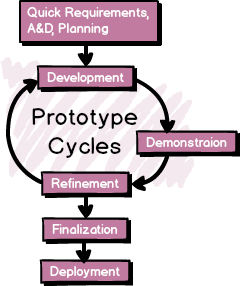Enterprise Rapid Application Development with LSPS
By Radovan Cervenka

Rapid Application Development (RAD) is a method of software development which heavily emphasizes adaptive evolutionary prototyping and iterative delivery over detailed specification and precise planning beforehand. This approach is also one of viable responses for increasing demand of the business for new applications at one side and lacking of IT to deliver them in time and required quality at the other side. Especially if the turnaround expected by the business for custom development projects is shrinking.
RAD is applicable mostly for small or middle-scaled projects, or parts of large projects, led by smaller groups of skilled developers, accompanied with clients or end-users open to cooperate in the development process and receiving the results frequently. If applied correctly, RAD enables to deliver applications quickly, with higher quality, at lower risks, and with better user acceptance.
Enterprise RAD (ERAD) is often an essential part of larger business (re-)engineering and innovation programs. These projects demand a greater level of business involvement as well as more frequent iterations to stay current within the market. The rapid prototyping approach of RAD is a key tool to help end-users and analysts “think out of the box” about innovative ways that technology might radically reinvent a core business process.
LSPS has been developed with application of (E)RAD in the development process in mind to speed-up the enterprise application development and to make it easier and faster than with conventional technologies. LSPS can be characterized a low-code development platform (LCDP) providing significant reduction of coding by domain-specific visual modeling used to provide higher-level abstractions for all important aspects of business application: business processes, intelligent business decisions, organization structure, business data and data constraints, user interface, application API, integration, and much more. The GO‑BPMN model is inherently executable, so it does not need to be transformed to application code manually. A valid model can be deployed and start running in seconds.
However, LSPS is not an end-user development or no-code development platform. To create a high-quality, customer-specific and performing applications with possibility to integrate with variety of public or in-house 3rd party systems (including customer-specific and legacy systems) requires IT professionals.
LSPS empowers the application prototyping by fast model-deploy-test-fix cycle. Automation of continuous releasing, testing and deployment makes the prototyping itself, but also the application finalization much seamless with minimal human intervention and therefore it’s less error-prone.
In addition, the modularity of a GO‑BPMN model allows to divide the application into independently developed and parallelly prototyped parts, while the overall system consistency and module integration is automatically checked and governed by the LSPS modeling ecosystem. Prototyping cycles running in parallel can even more speed-up the application development process.
In a number of very intensive customer projects LSPS has proven to be successfully applied not only for habitual prototyping of UI, but also user-observable application functionality, large-scale user interactions with the application (UI workflows, UX), business processes, performance of business, processing and integration with 3rd-party external systems. By usage of the evolutionary prototyping all these aspects of a business application can be incrementally developed and iteratively improved to the desired level of functionality, quality, and performance continuously controlled by end-users and customers.
